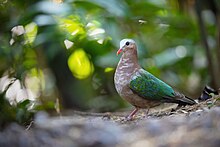Common emerald dove
| Common emerald dove | |
|---|---|

| |
| Scientific classification | |
| Domain: | Eukaryota |
| Kingdom: | Animalia |
| Phylum: | Chordata |
| Class: | Aves |
| Order: | Columbiformes |
| Family: | Columbidae |
| Genus: | Chalcophaps |
| Species: | C. indica
|
| Binomial name | |
| Chalcophaps indica | |
| Subspecies | |
|
See text | |
| Synonyms | |
|
Columba indica Linnaeus, 1758 | |
The emerald dove or common emerald dove (Chalcophaps indica), also called Asian emerald dove and grey-capped emerald dove, is a widespread resident breeding
Taxonomy
In 1743, the English naturalist
Six subspecies are recognised:[6]
- C. i. indica (Linnaeus, 1758) – India to south China, Malaysia, Philippines, Indonesian and west Papuan islands
- C. i. robinsoni Baker, ECS, 1928 – Sri Lanka
- C. i. maxima Hartert, 1931 – Andaman Islands
- C. i. augusta Bonaparte, 1855 – Nicobar Islands
- C. i. natalis Lister, 1889 – Christmas Island (Indian Ocean)
- C. i. minima Hartert, 1931 – Numfor, Biak and Mios Num islands (off north New Guinea)
Description


The common emerald dove is a stocky, medium-sized pigeon, typically 23–27 cm (9.1–10.6 in) in length.[7] The back and wings are bright emerald green. The flight feathers and tail are blackish, and broad black and white bars show on the lower back in flight. The head and underparts are dark vinous pink, fading to greyish on the lower belly. The eyes are dark brown, the bill bright red and legs and feet rufous. The male has a white patch on the edge of the shoulders and a grey crown, which the female lacks. Females will tend to have a browner complexion with a grey mark on the shoulder. Immature birds resemble females but have brown scallops on their body and wing plumage.
Distribution and habitat
This is a common species in
Behaviour and ecology
Emerald doves usually occur singly, pairs or in small groups.[9] They are quite terrestrial, often searching for fallen fruit on the ground and spending little time in trees except when roosting. They eat seeds and fruits of a wide variety of plants and are generally tame and approachable. They are rare and are usually found foraging in small groups or pairs. If there's a resource rich area, small groups will maintain a territory. Its flight is fast and direct, with the regular beats and an occasional sharp flick of the wings which are characteristic of pigeons in general. It often flies low between the patches of dense forest it prefers, but when disturbed will frequently walk away rather than fly. They are particularly good weavers when flying through forests. When flying they expose a buff underwing and a chestnut colour of their flight feathers.

The call is a low soft moaning cooing consisting of about six to seven coos starting quietly and rising. They also call a nasal "hoo-hoo-hoon". Males perform a bobbing dance during courtship.[10]
References
- . Retrieved 19 November 2021.
- ^ Edwards, George (1743). A Natural History of Uncommon Birds. London: Printed for the author, at the College of Physicians. p. 14, Plate 14.
- ^ Linnaeus, Carl (1758). Systema Naturae per regna tria naturae, secundum classes, ordines, genera, species, cum characteribus, differentiis, synonymis, locis (in Latin). Vol. 1 (10th ed.). Holmiae:Laurentii Salvii. p. 164.
- ISBN 978-1-4081-2501-4.
- ^ Gould, John (1843). The Birds of Australia. Vol. 5. London: self published. Plate 62 and text.
- ^ Rasmussen, Pamela, eds. (2020). "Pigeons". IOC World Bird List Version 10.1. International Ornithologists' Union. Retrieved 18 March 2020.
- ^ a b Baptista, L.F.; Trail, P.W.; Horblit, H.M.; Kirwan, G.M.; Garcia, E.F.J.; Boesman, P. (2020). del Hoyo, J.; Elliott, A.; Sargatal, J.; Christie, D.A.; de Juana, E. (eds.). "Grey-capped Emerald Dove (Chalcophaps indica)". Handbook of the Birds of the World Alive. Lynx Edicions. Retrieved 18 March 2020.
- ISBN 978-84-96553-87-3.
- ^ Nicolls, Martina (27 April 2019). "Common Emerald Dove". SIMILAR BUT DIFFERENT IN THE ANIMAL KINGDOM.
- Western Sydney Institute of TAFE.
- Grimmett, Birds of India, Inskipp and Inskipp, ISBN 0-691-04910-6

